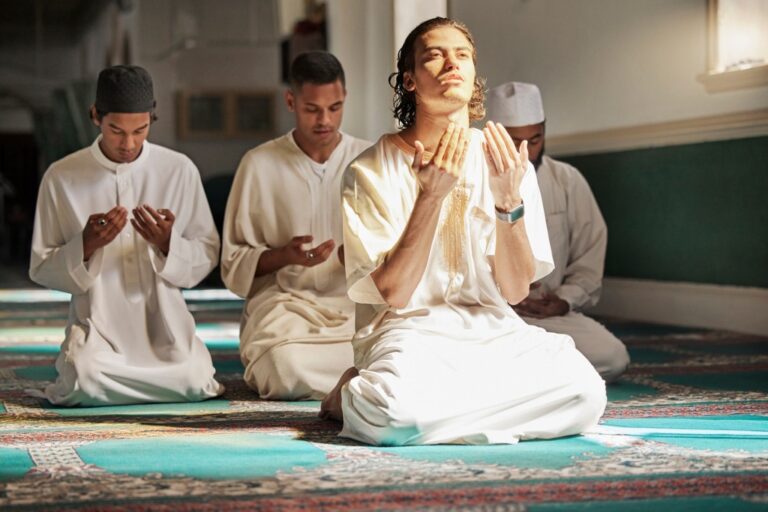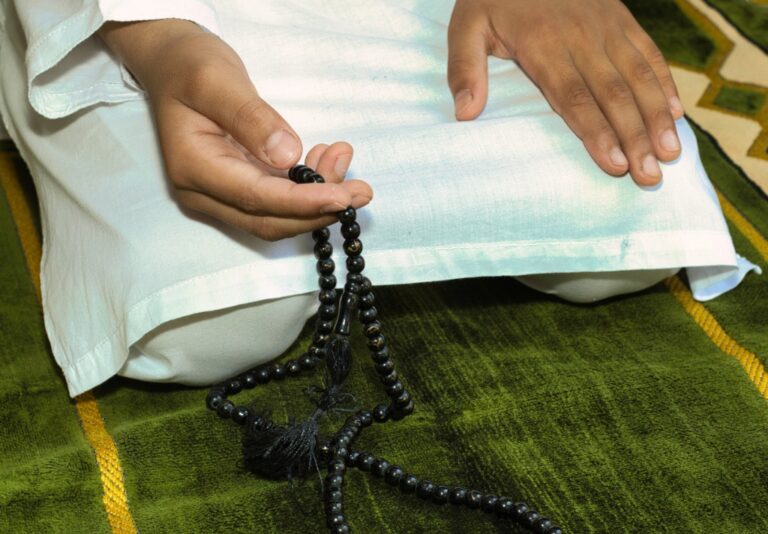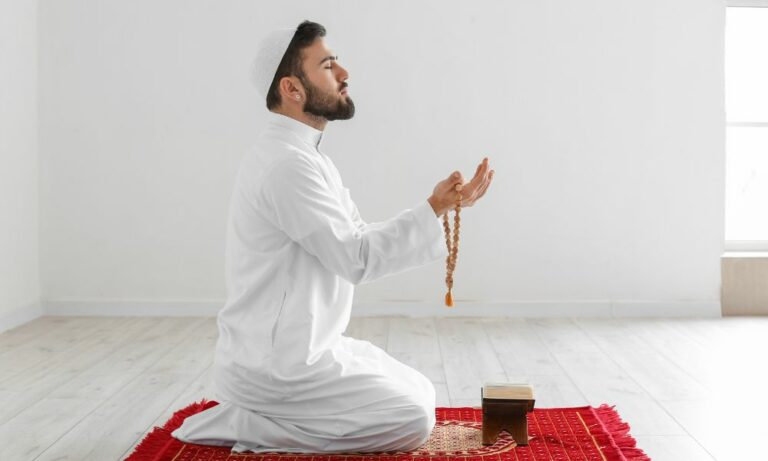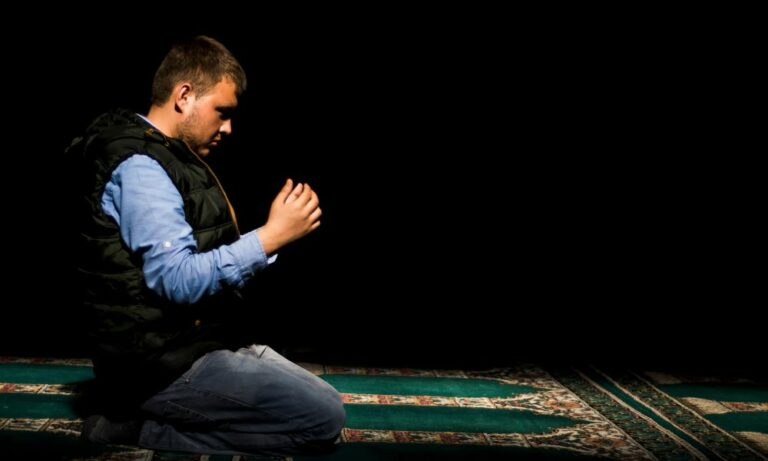How to perform Isha Prayer: Discover the Ultimate Guide to Perfecting Your Isha Prayer!
Understanding how to perform the Isha Prayer can be difficult, particularly for new converts. Isha, one of the five daily prayers required by Islam, is filled with significant rituals and recitations that require precision.
This blog will take you through each step of correctly and reverently performing this prayer, making it easier.
Are you ready to become an excellent worshipper? Let’s get started!
Understanding Isha Prayer


Salat al Isha, the last of Islam’s five daily prayers, is unique among all other Salah Times. According to Islamic tradition, it is performed after the twilight has passed. It is governed by several rules to ensure proper execution.
Niyyah, or intention, marks the start of this prayer, which requires your heartfelt commitment to pray Isha for the sake of Allah SWT.
This prayer is divided into three sections: four rak’aats Fard, two rak’aats Sunnah, and three rak’aats Witr. Al-Fatiha Surah is recited in every rak’aat.
Interestingly, there are some gender differences; females should recite in a soft voice, whereas males must recite aloud during Fajr, Maghrib, and the Isha prayers.
Understanding each step enhances our Salat experience and brings us closer to effectively fulfilling our religious obligations.
Steps to Perform Isha Prayer


To perform the Isha Prayer, start by performing the four Rak’aats Fard part, and then complete the two Rak’aats Sunnah part.
Executing the Four Rak’aats Fard Part
This essential part of Salat al Isha is vital in completing your daily prayers.
Intention and Dua of Istiftah:
The step is initiated by making a new Niyyah (Intention) for offering the Fard of Isha prayer. Following this declaration of intention, you recite “Takbir” and then begin uttering “‘SubhanakAllahumma, wa bihamdika tabarakasmuka wa ta’ala jadduka wa la ilaha ghairuk.” Sunan an-Nasa’i 900
Surah Fatiha


Then comes the recitation of Surah Al-Fatiha and another Quranic Surah, such as Surah An-Nas, or any other chapter from the Holy Quran other than Al-Fatiha. Book 2, Hadith 172, Sahih Muslim 396c
Remember to recite these parts quietly if you’re a female, while males recite them aloud during this late-night prayer session.
Bowing (Ruku) and Qawmah (Rising from bowing)
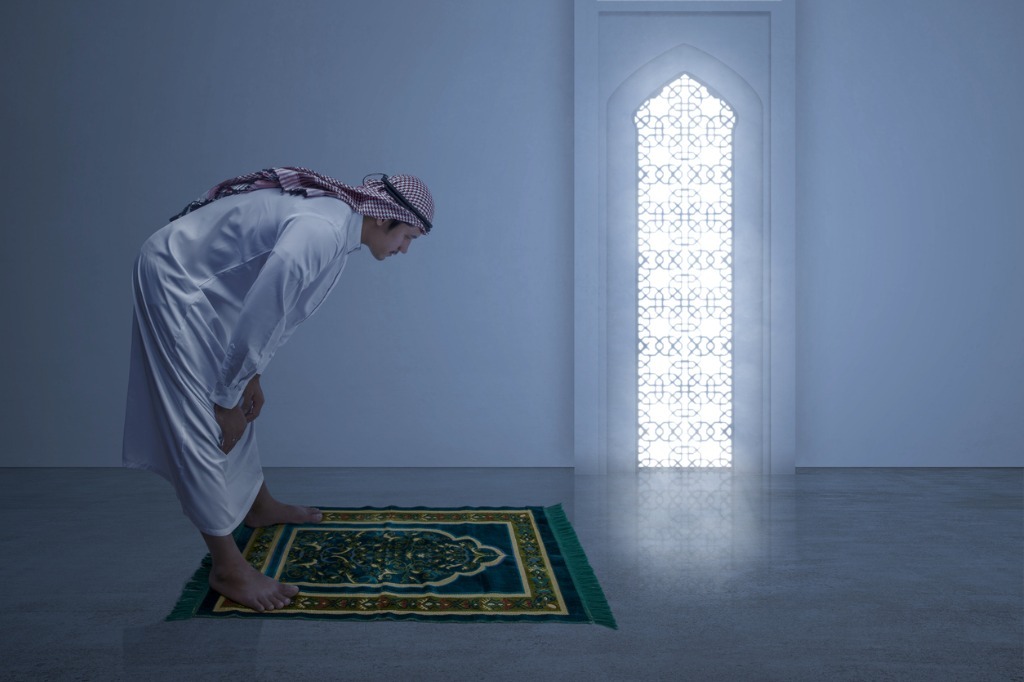

When going into ruku, say “Allahu Akbar”, then recite “Subhana Rabbi Al Adheem” 1 at least thrice. Now rise from ruku while saying “Sami Allahu Liman Hamidah” 2, then say “Rabbana Walakal Hamd.” 3
Prostration (Sajda)


Go into the prostration by saying “Allahu Akbar,” and during the prostration, recite “Subhana Rabbi Al A’la” 4 at least thrice. Rise from this position and sit. Each time you go into prostration and rise from it, you will say “Allahu Akbar.”
Jalsa (sitting between two prostrations)


After performing one sajda, sit and relax. This gap between the first and second prostration is known as Jalsah. You may recite “Rabbighfirli” 5 During it. Now perform the second prostration, and after that, stand up for the second Rakah.
Reciting Tashahud in Second Rakah


In the second Rakah, after the second prostration, don’t stand up. Instead, recite Tashahud and then stand up. The Third Rakah is the same as the first.
Concluding the Prayer
The Fourth Rakah also resembles the second, but After Tashahud 6, you recite Durood-e-Ibrahimi 7 and the Dua “Allahumma Rabbana atina fid dunya hasanah wa fil akhirati hasanah wa qina ‘adhaban nar” 8 and then you end the prayer by saying Tasleem (Salutation to end the prayer).
References:
- Riyad as-Salihin 1175,
- Sunan an-Nasa’i 1072,
- Sunan Ibn Majah 877
- Sunan an-Nasa’i 1046
- Sunan Ibn Majah 897
- Sahih al-Bukhari 831,
- Sahih al-Bukhari 3370 ,
- Sahih al-Bukhari 4522.
Carefully maintain focus and proper pronunciation throughout, without rushing through your prayer.
Completing the Two Rak’aats Final Sunnah Part
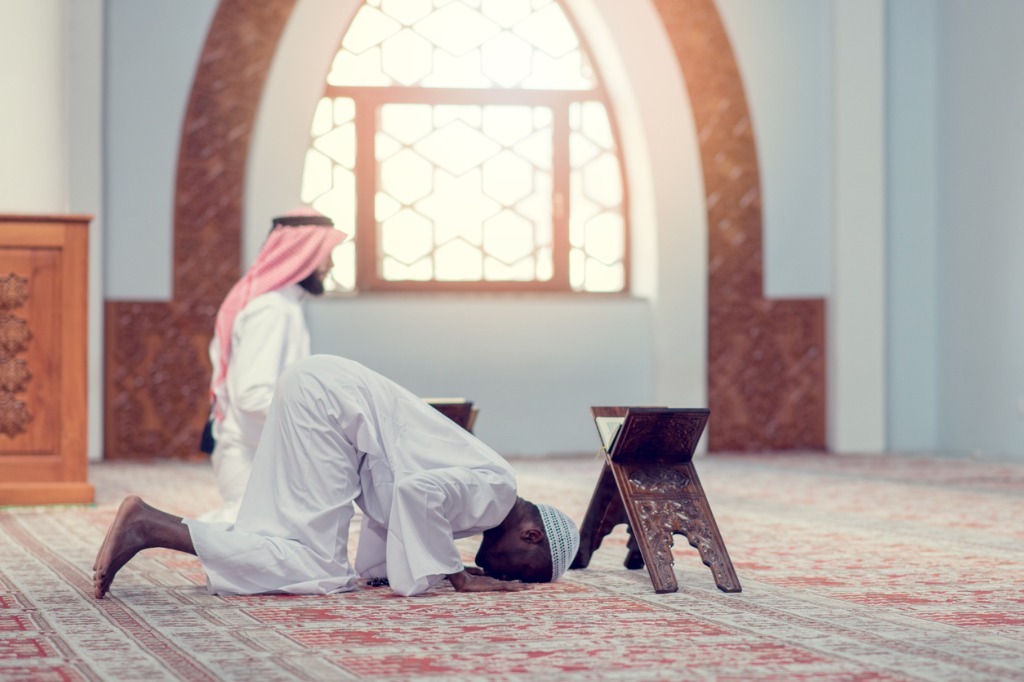

Following the completion of the four rak’aat Fard portion of the Isha prayer, there are two additional rak’aats known as Sunnah Muakkadah. These rak’aats are significant because they are a voluntary act of worship as well as an opportunity to earn additional rewards from Allah SWT.
During these two rak’aats, it is recommended to recite any chapter from the Holy Quran after Surah Al-Fatiha.
The difference between these two rakaats and the Fard one is in the intention. You end the prayer with taslim instead of standing up in the second Rakah after Tashahud.
These two Sunnah are among the twelve Sunnah mentioned in a hadith by Prophet Muhammad PBUH.
مَنْ ثَابَرَ عَلَى ثِنْتَىْ عَشْرَةَ رَكْعَةً مِنَ السُّنَّةِ بَنَى اللَّهُ لَهُ بَيْتًا فِي الْجَنَّةِ أَرْبَعِ رَكَعَاتٍ قَبْلَ الظُّهْرِ وَرَكْعَتَيْنِ بَعْدَهَا وَرَكْعَتَيْنِ بَعْدَ الْمَغْرِبِ وَرَكْعَتَيْنِ بَعْدَ الْعِشَاءِ وَرَكْعَتَيْنِ قَبْلَ الْفَجْرِ ”
“Whoever is regular with twelve Rak’ah of Sunnah (prayer), Allah will build a house for him in Paradise: Four Rak’ah before Zuhr, two Rak’ah after it, two Rak’ah after Maghrib, two Rak’ah after Isha, and two Rak’ah before Fajr.”
Performing the Witr
It is the sunnah of the Prophet Muhammad PBUH to pray Witr alongside Tahajjud prayer (the one-third of night prayer). He advised Muslims to pray Witr alongside Isha if they are worried about not being able to wake up at night.
مَنْ خَافَ أَنْ لاَ يَقُومَ مِنْ آخِرِ اللَّيْلِ فَلْيُوتِرْ أَوَّلَهُ
If anyone is afraid that he may not get up in the latter part of the night, he should observe Witr in the first part of it;
In a hadith, Prophet Muhammad PBUH also told us about its number of Rak’aats:
الْوِتْرُ حَقٌّ. فَمَنْ شَاءَ فَلْيُوتِرْ بِخَمْسٍ. وَمَنْ شَاءَ فَلْيُوتِرْ بِثَلاَثٍ. وَمَنْ شَاءَ فَلْيُوتِرْ بِوَاحِدَةٍ ”
“Witr is Haqq.* Whoever wishes let him pray Witr with five (Rak’ah), and whoever wishes let him pray Witr with three (Rak’ah), and whoever wishes let him pray Witr with one (Rak’ah).”
We also understand from some ahadith in which the prophet Muhammad PBUH prayed seven or nine rak’aats of Witr. Sahih Muslim 737a, Sunan an-Nasa’i 1714. Sunan Ibn Majah 1191
Most Muslims prefer three rak’aats of Witr prayer, similar to three Fard rak’aats of Maghrib but differs slightly. In the third Rakah of the Witr prayer, after we say “sami’a Allahu leman hamedah”, we perform Dua-e-Qunoot.
“ اللَّهُمَّ اهْدِنِي فِيمَنْ هَدَيْتَ وَعَافِنِي فِيمَنْ عَافَيْتَ وَتَوَلَّنِي فِيمَنْ تَوَلَّيْتَ وَبَارِكْ لِي فِيمَا أَعْطَيْتَ وَقِنِي شَرَّ مَا قَضَيْتَ إِنَّكَ تَقْضِي وَلاَ يُقْضَى عَلَيْكَ وَإِنَّهُ لاَ يَذِلُّ مَنْ وَالَيْتَ وَلاَ يَعِزُّ مَنْ عَادَيْتَ تَبَارَكْتَ رَبَّنَا وَتَعَالَيْتَ ”
“O Allah, guide me among those Thou hast guided, grant me security among those Thou hast granted security, take me into Thy charge among those Thou hast taken into Thy charge, bless me in what Thou hast given, guard me from the evil of what Thou hast decreed, for Thou dost decree, and nothing is decreed for Thee. He whom Thou befriendest is not humbled. Blessed and Exalted art Thou, our Lord.”
Tips for Concentration During Isha Prayer
Maintaining focus and concentration during the Isha Prayer can be challenging, especially after a long day. Here are some tips to help you stay focused and connected during this important prayer:
- Find a Quiet Place: Select a peaceful and quiet location where you can pray without distractions. This will contribute to creating a calm environment that will aid in concentration.
- Mentally Prepare: Before beginning your prayer, take a few moments to clear your mind and mentally prepare yourself for the act of worship. Remember the importance of the Isha Prayer and the opportunity to connect with Allah SWT.
- Slow down your pace: Take your time as you complete each part of the prayer. Avoid rushing through your movements and instead, concentrate on being present in every moment.
- Reflect on the Meaning: Try to reflect on the meanings of Surahs and prayer positions as you recite them. Understand spoken words’ meaning and importance in your relationship with Allah SWT.
Common Mistakes to Avoid During Isha Prayer
- Rushing through the prayer without properly performing each position.
- Failure to recite Surah Al-Fatiha during all rak’aats of the Isha Prayer.
- Not fully bending when performing ruku (the bowing position) or touching the forehead to the ground when performing sujood (prostration).
- Allowing thoughts to wander or becoming distracted during prayer breaks concentration.
Conclusion
Performing the Isha Prayer holds great importance. Following the outlined steps and remaining focused during the prayer can establish a deep connection with Allah SWT.
To truly benefit from this beautiful act of worship, ensure that you make sincere intentions and strive for concentration. May your Isha prayers bring you peace and blessings, and strengthen your bond with Allah SWT. Stay committed to this essential aspect of your faith, and may it bring you spiritual fulfillment and closeness to your Creator.
FAQs
What is Isha prayer, and when should it be performed?
Isha prayer, also known as night prayer, is one of Islam’s five daily prayers. It takes place after sunset and before midnight.
How many rak’aats (units) are there in Isha prayer?
In general, there are 9 rak’aats: Four rak’aat Fard, two rak’aat Sunnah, and three rak’aat Witr.
What recitations and movements are involved in Isha prayer?
Various recitations from the Quran are made in each rak’ah of Isha prayer, including Al-Fatihah (the opening chapter) and additional verses or chapters. These recitations are accompanied by specific movements such as standing, bowing (raku), prostration (sujood), and sitting.
Can women perform Isha prayer at home instead of attending a mosque?
Yes, women can pray at home if they prefer for reasons such as convenience or safety. However, Muslims are encouraged to attend congregational prayers at mosques whenever possible because it promotes community unity and spiritual connection with other worshippers.
كيفية أداء صلاة العشاء: اكتشف الدليل النهائي لإتقان صلاة العشاء!
قد يكون فهم كيفية أداء صلاة العشاء أمرًا صعبًا، خاصة بالنسبة للمتحولين الجدد. صلاة العشاء، وهي إحدى الصلوات الخمس اليومية التي يتطلبها الإسلام، مليئة بطقوس وتلاوات مهمة تتطلب الدقة. ستأخذك هذه المدونة خلال كل خطوة من خطوات أداء هذه الصلاة بشكل صحيح وخشوع، مما يجعل الأمر أسهل. هل أنت مستعد لأن تصبح عابدًا ممتازًا؟ هيا بنا نبدأ!فهم صلاة العشاء


خطوات أداء صلاة العشاء


تنفيذ الأربع ركعات عتس الفرض الجزء
هذا الجزء الأساسي من صلاة العشاء ضروري لإكمال صلواتك اليومية.نية ودعاء الاستفتاح:
تبدأ الخطوة بإقامة نية جديدة لصلاة فرض صلاة العشاء. بعد إعلان النية هذا تقرأ "التكبير" ثم تبدأ في نطق "سبحانك الله وبحمدك تبارك وتعالى جدك ولا إله غيرك".< /span>" سنن النسائي 900سورة الفاتحة


الركوع والقومة (الرفع من الركوع)


السجود


الجلسة (الجلوس بين السجدتين)


قراءة التشهد في الركعة الثانية


اختتام الصلاة
الركعة الرابعة تشبه الثانية أيضًا ولكن بعد التشهد 6, تقرأ الصلاة الإبراهيمية 7 ودعاء "اللهم ربنا آتينا في الدنيا حسنة وفي آخرتي حسنة وقنا عذب نارا" 8 ثم تختم الصلاة بالتسليم.المراجع:
- رياض الصالحين 1175,
- سنن النسائي 1072,
- سنن ابن ماجه 877
- سنن النسائي 1046
- سنن ابن ماجه 897
- صحيح البخاري 831,
- صحيح البخاري 3370 ,
- صحيح البخاري 4522.
استكمال ركعتين ايات السنة الاخيرة الجزء


أداء الوتر
من سنة النبي محمد صلى الله عليه وسلم أن يصلي الوتر مع صلاة التهجد (صلاة ثلث الليل). ونصح المسلمين بصلاة الوتر إلى جانب العشاء إذا كانوا يشعرون بالقلق من عدم قدرتهم على الاستيقاظ في الليل. مَنْ خَافَ أَنْ لاَ يَقُومَ مِنْ آخِرِ اللَّيْلِ فَلْيُوتِرْ أَوَّلَهُ من خاف ألا يقوم في آخر الليل فليوتر في أوله. صحيح مسلم 755أ وفي الحديث أيضًا أخبرنا النبي محمد صلى الله عليه وسلم عن عدد ركعاتها: الْوِتْرُ حَقٌّ. فَمَنْ شَاءَ فَلْيُوتِرْ بِخَمْسٍ. وَمَنْ شَاءَ فَلْيُوتِرْ بِثَلاَثٍ. وَمَنْ شَاءَ فَلْيُوتِرْ بِوَاحِدَةٍ " "الوتر حق فمن شاء فليوتر بخمس ومن شاء فليوتر بثلاث ومن شاء فليوتر بثلاث ومن شاء فليوتر بثلاث ومن شاء فليوتر بثلاث ومن شاء فليوتر بثلاث ومن شاء فليوتر بثلاث ومن شاء فليوتر بثلاث" من شاء أن يصلي الوتر بواحدة». كما نفهم من بعض الأحاديث أن النبي محمد صلى الله عليه وسلم صلى فيها سبع أو تسع ركعات الوتر. صحيح مسلم 737أ,< a href="https://sunnah.com/nasai:1714"> سنن النسائي 1714. سنن ابن ماجه 1191 يفضل معظم المسلمين صلاة الوتر بثلاث ركعات، تشبه ثلاث ركعات الفرض في المغرب ولكن مع اختلاف بسيط. وفي الركعة الثالثة من صلاة الوتر بعد أن نقول "سمع الله لمن حمده" نقوم بدعاء القنوت. " اللَّهُم اهْدِنِي فِيمَنْ هَدَيْتَ وَعَافِنِي فِيمَنْ عَافَيْتَ وَتَوَلَّنِي فِيمَنْ تَوَلَّيْتَ وَبَارِكْ لِي فِيمَا أَعْطَيْتَ وَقِنِي شَرَّ ما ما قَضَيْتَ إِنَّكَ تقْضِي وَلاَ يُقْضَ عَلَيْكَ وَإِنَّهُ لاَ يَذِلُّ مَنْ وَالَيْتَ وَلاَ يَعِزُّ مَنْ عَادَيْتَ تَبَارَكْتَ رَبَّنَا وَتَعَالَيْتَ ""اللهم اهدني فيمن هديت، وآمنني فيمن عافيت، وتولني فيمن توليت، وبارك فيك" وقني في ما أعطيت، وقني شر ما قضيت، فإنك تقضي ولا يقضي عليك شيء. فترة> سنن أبي داود 1425نصائح للتركيز أثناء صلاة العشاء
الحفاظ على التركيز أثناء صلاة العشاء قد يكون أمرًا صعبًا، خاصة بعد يوم طويل. إليك بعض النصائح لمساعدتك في الحفاظ على التركيز والتواصل أثناء هذه الصلاة المهمة:- ابحث عن مكان هادئ: اختر مكانًا هادئًا وهادئًا حيث يمكنك الصلاة دون تشتيت الانتباه. وهذا سوف يساهم في خلق بيئة هادئة تساعد على التركيز.
- الاستعداد العقلي: قبل أن تبدأ صلاتك، خذ بضع دقائق لتصفية ذهنك وإعداد نفسك ذهنيًا للعبادة. تذكر أهمية صلاة العشاء وفرصة التواصل مع الله سبحانه وتعالى.
- أبطئ وتيرتك: خذ وقتك وأنت تكمل كل جزء من الصلاة. تجنب التسرع في حركاتك وبدلاً من ذلك ركز على التواجد في كل لحظة.
- تدبر المعنى: حاول أن تتفكر في معاني السور ومواضع الصلاة أثناء تلاوتها. افهم معنى الكلمات المنطوقة وأهميتها في علاقتك بالله سبحانه وتعالى.
أخطاء شائعة يجب تجنبها أثناء صلاة العشاء
- التعجل في الصلاة دون أداء كل موضع بشكل صحيح.
- التخلف عن قراءة سورة الفاتحة في جميع ركعات صلاة العشاء.
- عدم الانحناء الكامل عند الركوع أو ملامسة الجبهة للأرض عند السجود.
- السماح للأفكار بالتجول أو التشتت أثناء التركيز في استراحة الصلاة.


